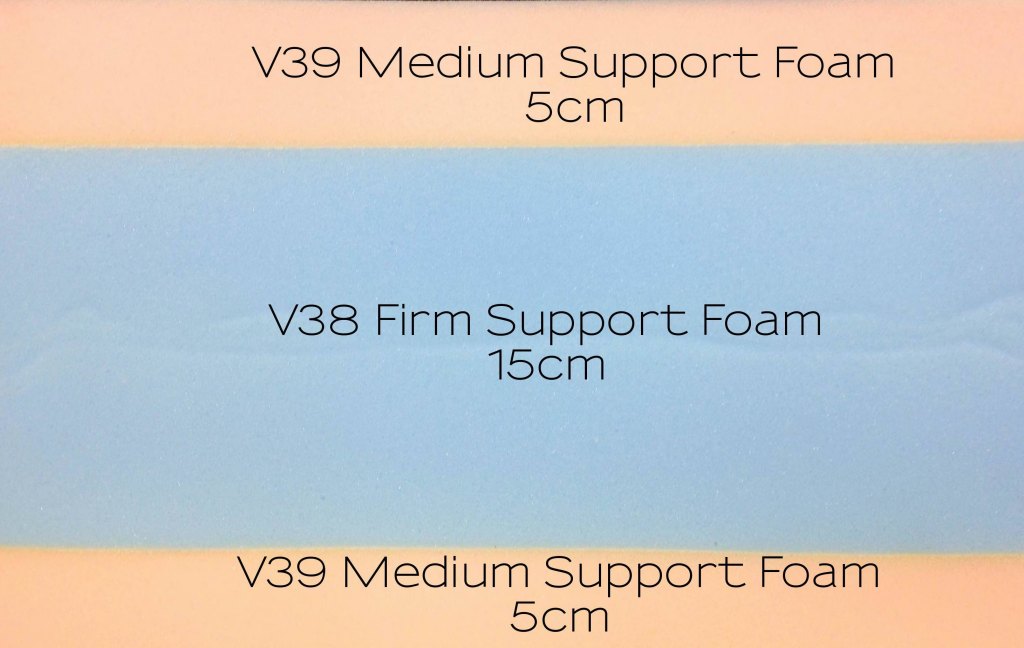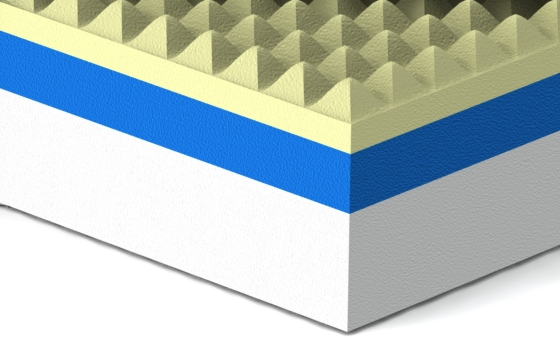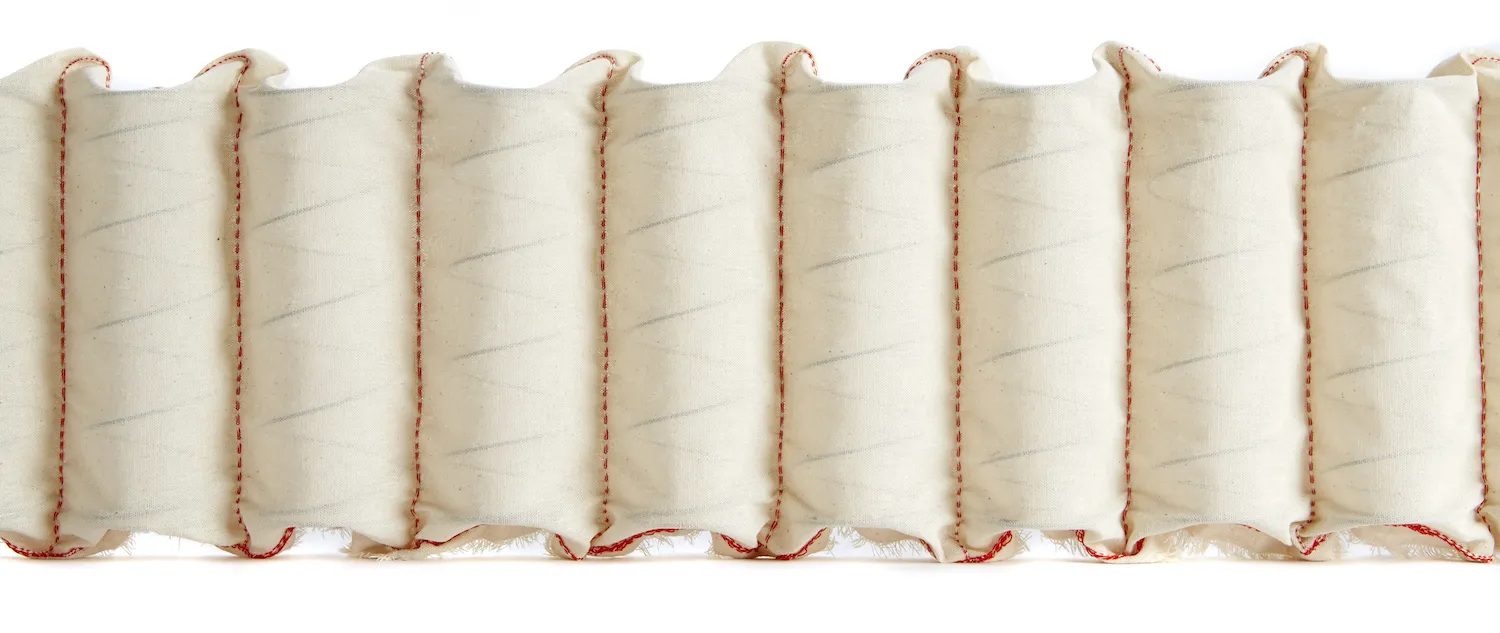Memory Foam & Hybrid Foam
April 2023What is reflex mattress foam?
If you’ve been looking at a foam mattress such as Memory foam, Eve, Casper or Simba you may have come across the term ‘support foam’. Each brand has its own proprietary support foam which we will explain are all derivatives of ‘Reflex foam’. This article will help explain what support foams and reflex foams are and why they are used in foam mattresses.

What is reflex foam?
Reflex foam, also known as reflex foam mattress or high-density foam, is a type of polyurethane foam that is commonly used in mattresses and other cushioning applications. Often found in cinema seats, car seats, entry level mattresses and other high usage upholstery.
It is known for its supportive and durable properties, making it a popular choice for mattress cores or as a component in mattress toppers.
Reflex foam is made from polyurethane, a synthetic material that is created by combining chemicals and undergoing a foaming process to produce a foam with specific properties. The term “reflex” refers to the foam’s ability to quickly return to its original shape after being compressed or deformed, which gives it its resilience and supportiveness.
It’s popular in mass produced mattresses as its relatively cost effective compared to high quality calico pocket springs. It’s an entry level material when it comes to mattress design.
Characteristics of reflex foam
Reflex foam has many uses and benefits which include:
- Firmness: Reflex foam is typically firmer than traditional memory foam, which is known for its conforming and pressure-relieving properties. Reflex foam provides a firmer feel, making it suitable for those who prefer a more supportive surface or need additional support for their back or joints.
- Density: Reflex foam is denser than standard polyurethane foam, which makes it more durable and long-lasting. Higher density reflex foam tends to be more supportive and resilient, but it may also feel firmer.
- Breathability: Reflex foam generally has good breathability and airflow properties, which can help dissipate heat and moisture, making it more comfortable to sleep on compared to some other foam materials.
- Allergen resistance: Reflex foam is typically hypoallergenic and resistant to allergens such as dust mites, mold, and mildew, which can be beneficial for individuals with allergies or sensitivities.
- Versatility: Reflex foam can be found in various thicknesses, densities, and firmness levels, making it suitable for different mattress types, including mattresses for beds, sofas, and other seating or bedding applications.
It’s worth noting that the specific properties and performance of reflex foam can vary depending on the manufacturing process, density, and formulation used by different manufacturers. When choosing a mattress or mattress topper with reflex foam, it’s important to consider your individual comfort preferences, support needs, and any other factors that are important to you in a mattress.
What is reflex mattress foam used for?
Reflex or the base foam (the part of the mattress under the memory foam) is the denser and firmer supportive part of the mattress. We use British Vita foams reflex branded foam mainly as a mattress insulator on entry-level mattresses. These come in a different density rating, usually 30kg (Soft) to 33kg (Firm). Very few manufacturers give you any detail on this part of the mattress, but we do! The British Vita foam reflex foam we use is solid filler-free, unlike cheaper PU foams which are a mix of different foams.
The highlighted area in the image below is the Reflex layer of the mattress, shown as a white foam. See our data sheets for all the foams here.

A standard memory foam mattress comprises of the memory foam top layer and then either one or more layers of Memory Foam or reflex foam. The best way to imagine it, because we really like old fashioned cakes, is that memory foam is the soft icing on a fruit cake, and the reflex foam is the firm fruit cake base that supports the icing.
There may be other ‘marzipan’ layers present but the reflex foam is the base, and this offers you your support.
| Foam Grade | Density Min KG/M3 | Density Max KG/M3 | Hardness Min (n) | Hardness Max (n) |
|---|---|---|---|---|
| Reflex 300 | 30 | 32 | 100 | 130 |
| Reflex 300F | 30 | 32 | 130 | 160 |
Density and hardness are quoted according to in-house test methods based upon BS EN ISO 845 and BS EN ISO 2439 respectively.
Reflex can also be used to firm up upholstery layers such as in our Origins Pocket Reflex 1000 model. It can help provide a firmer consistent top layer when matched with softer elements such as polyester.
Reflex foam grades explained
Reflex foam is manufactured to different grades or densities which each manufacturer has to detail.
Unlike memory foams, reflex foams come in two main densities:
- 30kg density reflex foam – firm support
- 33kg density reflex foam -very firm support
They don’t match up with other foam densities which you may see at 70-80kg this is because reflex foam has a far higher hardness rating meaning they are much firmer at a lower density. This can often confuse people looking to choose a new foam mattress.
The bottom line is reflex foam is always far firmer than memory or latex foam.
Mattress Support Foam Explained
There is also another set of foams used in Mattresses and these are identified by a V rating and a number. These foams are high support foams used in seating, car seats and mattresses that must offer support for heavier sleepers such as 22-30 stone sleepers.
These V support foams are excellent at both resilience and support and can be coupled together to make a superbly comfortable yet supporting mattress for heavier sleepers or those who want an ultra firm mattress. As these V foams have such a high hardness and tolerance for resilience against heavier weights they can provide a much stronger mattress in terms of longevity.
V Foam mattresses for heavier sleepers
Our resilience range features V38 a firm support foam and V39 a medium support foam that can handle repeat pressure whilst still keeping its shape. For more information please see our two Resilience models made specifically for a heavier sleeper or someone wanting much more resilient support.
An example of support foams can be seen below.

Memory Foam Support Explained
As we mentioned before, each memory foam mattress brand will have its own version of reflex foam, usually branded to muddy the water even more! This makes comparing mattresses even harder. Below is a list of reflex foam equivalents.
- Durabase Technology in Tempur Mattresses
- Base foam the term used by Eve mattresses
- Durable base foam is the term Casper uses
- Zoned support base foam used by the Simba mattress company
What they all have in common is they are all high-density support foam very similar to reflex foam. You need to ask these brands what the depth and density is to fully compare their mattresses.
Does Reflex Foam smell?
There is a smell usually present with all foam mattresses as they ‘Offgass’. This usually dissipates in a week or so but some people can be hypersensitive to the smell of new foams and mattresses. Good ventilation can help reduce it or choosing a more Natural Fibre mattress that has fewer chemical compounds to offgass within it.
Is reflex foam different from memory foam?
Yes, Reflex foam is far firmer than memory foam and is not as viscoelastic meaning it doesn’t mould as quickly to the body like memory foam. It’s still heat retentive like all foams are when compared to natural fibre upholstery. This can lead to sleepers getting far hotter than they would in a wool and horsehair mattress. Memory foam has an open-cell structure meaning it can trap air and heat and then mould to the sleeper. More often than not Reflex is used beneath memory foam as the support layer.

Reflex foam Vs Memory Foam
- Reflex foam is far firmer than memory foam
- Memory foam needs heat to mould and react, reflex just needs pressure
- Memory foam has a far stronger off gassing smell than reflex foam
- Reflex foam is far cheaper than memory foam
- Refelx foam has a longer lifespan than memory foam
- Memory foam tends to sag or settle far faster than reflex foam
What’s a better alternative to reflex mattress foam?
If your budget allows, then a Pocket Spring unit is always preferable to a Reflex foam support layer.
Pocket springs are better than reflex foam for the following reasons:
- Pocket springs work independently whereas Reflex foam is one solid mass of support
- Pocket Springs are far more breathable compared to foams
- You can choose different gauges and tensions of springs based on your bodyweight whereas Reflex foam comes in only firmer tensions (It’s not suitable for lighter sleepers)
- Pocket springs don’t suffer from the compression rates that foam does and therefore have a significantly longer lifespan.
What is a reflex foam mattress?
A reflex foam mattress is usually a mix of reflex foam for the base and then some form of softer comfort layer on top. usually lighter foam or memory foam. In some cases, though especially with super cheap beds a reflex foam mattress is just a solid slab of reflex foam. However, it’s very unusual to find a solid reflex foam mattress in most mattress showrooms and furniture stores.
The only places you’ll find solid reflex foam mattresses without additional comfort layers are:
- Caravan mattresses
- Entry level beds
- Prisons
- Hospital
- Hostels
They are used in these places because reflex foam mattresses are super cheap and hard to damage. The drawback is that a solid reflex foam mattress is also incredibly uncomfortable to sleep on for 99% of sleepers!

Pocket Springs are a far better alternative to Reflex foam. They are cooler, more breathable and can be created specifically for your bodyweight unlike firm foam.
Summary
Reflex foam is the undersung hero of support in an entry-level/foam-based mattresses. Whilst there is nothing super-advanced about it, it does do a great job to provide support in a foam construction mattress. It is an entry-level priced component and will be found in entry-level mattresses. However, if you are looking for a handcrafted high-end mattress, then you should be looking for more natural advanced construction methods.

Dreaming of the perfect nights sleep?

Ask us a question
There are over 6000 questions and answers submitted by you on all questions about mattresses and bed problems. Enter a keyword such as Vi Spring, John Lewis beds, bad back or Memory Foam and see if your question has already been answered.
If you can’t find an answer in knowledge hub, ask a new question. We aim to respond to all questions within one working day.
Newsletter
Enter your email to join our newsletter. We’ll send you occasional news and mattress expertise.
